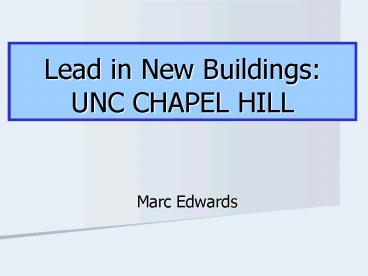Lead in New Buildings: UNC CHAPEL HILL PowerPoint PPT Presentation
1 / 24
Title: Lead in New Buildings: UNC CHAPEL HILL
1
Lead in New BuildingsUNC CHAPEL HILL
- Marc Edwards
2
- Background Lead in New Buildings.
- Preliminary Findings on Lead at UNC
- Focus on the worst samples
- How bad is/was the problem?
- Mitigating the Problem
- Short-term Minimizing Exposure/Flushing
- Intermediate-term Fine-tuning the
Chemistry - Longer-term Changing the
Plumbing Code
3
The Cause of the ProblemLead Free Brass
- 1986 Safe Drinking Water Act Lead Ban
- Pipes and solders lt 0.2 lead by weight
- Brass lt 8 lead by weight
- Lead free brass can legally contain
- up to 8 lead by weight
4
(No Transcript)
5
Also pumps, valves, water meters, backflow
preventors, etc.
6
Why Leaded Brass in the First Place?
- Pb (up to 8 by weight) added to brass in order
to - seal leaks
- improve corrosion resistance
- ease machining of intricate brass devices
Most modern brass products contain lt 3 Pb
7
Other information
- Higher purity waters (lower alkalinity, etc) more
likely to leach lead from brass - Rainwater and distilled water extremely
aggressive - Water at UNC is very pure
- Corrosivity mostly countered by raising pH and
adding inhibitor
8
In most cases lead leaching from brass drops off
with age
9
40
30
20
Pb (ppb)
LCR Action Level 15 ppb
10
Test Water
0
3
4
5
10
11
12
17
18
19
Sampling Day
10
But some waters are more aggressive to brass, and
cause lead leaching to rise for a time before
falling
11
40
30
Low Alkalinity-
Low pH Water
20
Pb (ppb)
LCR Action Level 15 ppb
10x
NSF Test Water
10
0
3
4
5
10
11
12
17
18
19
Sampling Day
Lower pH-Lower Alkalinity Water more
aggressive
12
UNC LEAD PROBLEM
- UNIVERSITY WAS VERY AGGRESSIVE IN SEEKING OUT
WORST CASE SAMPLES - Removed brass plug to sample water from backflow
preventor - Removed aerators to sample faucets
- Sampled hot water
- MANY SAMPLES COLLECTED WITH ALARMING LEVELS OF
LEAD (gt 500 ppb)
13
No alarming lead values came from appropriate
samples of drinking water.
- Removing brass plugs and aerators before
sampling, creates metal turnings, essentially
adding fine pieces of brass to samples and giving
high lead values - Lead values in recent sampling using conventional
approaches indicates a significant, lower level
lead problem, consistent with brass in new builds
14
Beres Samples
- 6 samples collected afternoon of 2/13/07
- Caudill Labs floors G, 1 and 3 specifically the
Men's restroom faucets and the drinking fountains
in the SW corridor - No building flushing at the time and
representative of water people were drinking (but
not first draw) - 5 of 6 samples tested
- Highest lead was 3.3 ppb
15
Beres Samples (Contd)
- 143 313 ppb Cu
- 25 - 270 ppb Zn
Group taste threshold for Cu2 400 ppb
Evaluation of Copper Speciation and Water Quality
Factors That Affect Aqueous Copper Tasting
Response Jonathan D. Cuppett, Susan E. Duncan
and Andrea M. Dietrich Chemical Senses 2006
31(7)689-697 doi10.1093/chemse/bjl010
16
The lower level lead problem has responded well
to flushing and cleaning of aerators
- Building pipes were not thoroughly cleaned with
aerators off when commissioned, or if it was
cleaned, it was not successful - Flushing drops lead by removing sediments and
hastening formation of protective film on brass
17
- CAUSE OF THE LOW LEVEL LEAD PROBLEM
8.0 x 10-3 in2/mL
18
Meringue dezincification
- gt pH 8.2
- High Ratio
- Cl-HCO3-
- Hot Water
Zinc enriched scale forming in brass from home
with complaint elsewhere in water system
19
Turner Diagram
(15 mg/L hardness, 14 mg/L Cl-)
20
OWASA Lead Study(12 waters x triplicate
conditions)
21
Preliminary Trends(OWASA RESEARCH)
22
Unusual problem can get better at lower pH!
23
Legislation
- Lead Free Drinking Water Act
- Would reduce allowable lead to 0.25
- Reintroduced a few weeks ago
- CA Assembly Bill 1953
- Limits the amount of lead in brass at wetted
surfaces to lt 0.25
24
Acknowledgements
- UNC Administration
- OWASA

